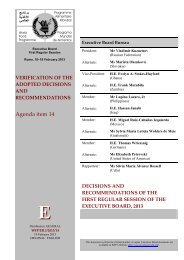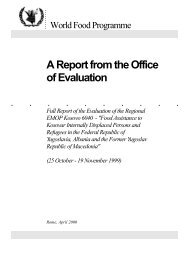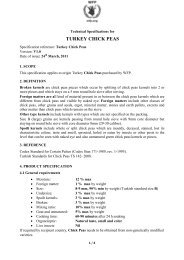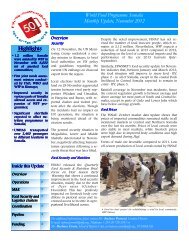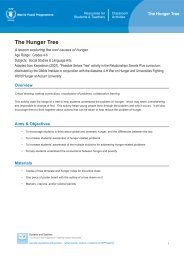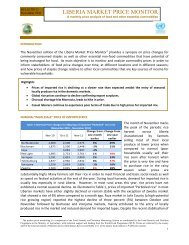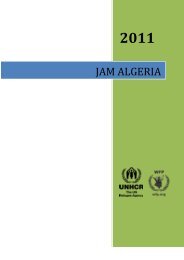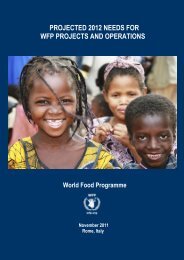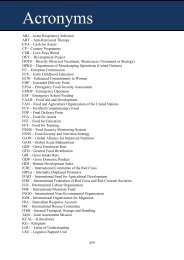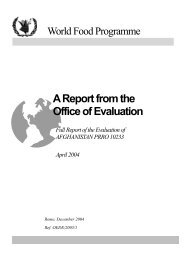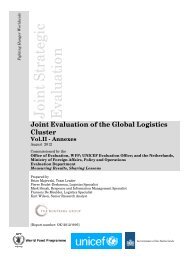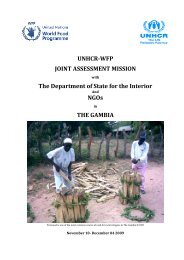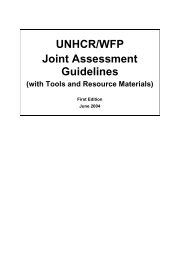The Potential for Scale and Sustainability in Weather Index Insurance
The Potential for Scale and Sustainability in Weather Index Insurance
The Potential for Scale and Sustainability in Weather Index Insurance
Create successful ePaper yourself
Turn your PDF publications into a flip-book with our unique Google optimized e-Paper software.
THE POTENTIAL FOR SCALE AND SUSTAINABILITY IN WEATHER INDEX INSURANCE<br />
FOR AGRICULTURE AND RURAL LIVELIHOODS<br />
the areas were evaluated <strong>and</strong> verified <strong>for</strong> accuracy. <strong>The</strong>se data were used to determ<strong>in</strong>e a<br />
long-term average monthly ra<strong>in</strong>fall. Long-term averages are reviewed on maps to determ<strong>in</strong>e<br />
any abnormal weather patterns or significant differences with<strong>in</strong> an area. A historical ra<strong>in</strong>fall<br />
average is available onl<strong>in</strong>e <strong>for</strong> decision reference. Maximum daily <strong>and</strong> monthly ra<strong>in</strong>fall caps<br />
are applied to the ra<strong>in</strong>fall data, recogniz<strong>in</strong>g that the benefit of <strong>in</strong>creased ra<strong>in</strong>fall has a limit.<br />
<strong>The</strong> daily cap is 50 mm of ra<strong>in</strong>fall, <strong>and</strong> the monthly cap is 125 per cent of the monthly<br />
historical average ra<strong>in</strong>fall.<br />
Premium rates <strong>and</strong> subsidies<br />
<strong>The</strong> entire adm<strong>in</strong>istrative cost <strong>and</strong> about 60 per cent of the premium (depend<strong>in</strong>g on the<br />
coverage option) are paid by government. Adm<strong>in</strong>istrative costs of the Forage Ra<strong>in</strong>fall Plan<br />
are split between the federal <strong>and</strong> Ontario governments on a 60/40 basis. In 2008, the<br />
producers’ share of the premium <strong>for</strong> the base plan, monthly weight<strong>in</strong>g <strong>and</strong> three-month<br />
options was 40 per cent. <strong>The</strong> producers’ share of the bimonthly option was 40 per cent of<br />
the portion of the premium equal to the base option, <strong>and</strong> 67 per cent of the rema<strong>in</strong><strong>in</strong>g<br />
portion. Forage Ra<strong>in</strong>fall Plan premiums are tax-deductible. Table 16 shows basic premium<br />
rates charged to producers (net of subsidy). <strong>The</strong>se premium rates are constant across<br />
ra<strong>in</strong>fall-report<strong>in</strong>g stations.<br />
Payouts<br />
<strong>Insurance</strong> payments are made whenever ra<strong>in</strong>fall is less than 80 per cent of the long-term<br />
average <strong>for</strong> the area. <strong>The</strong> payment is determ<strong>in</strong>ed by the follow<strong>in</strong>g <strong>for</strong>mula:<br />
Claim payment = (80% – % ra<strong>in</strong>fall) x coverage amount x value option factor<br />
<strong>The</strong> value option factor is always 2, because AgriCorp doubles the claim amount to<br />
account <strong>for</strong> the cost of transport<strong>in</strong>g purchased replacement <strong>for</strong>age. Per cent ra<strong>in</strong>fall equals<br />
the ratio of the sum of capped actual ra<strong>in</strong>fall 45 to the sum of historical average ra<strong>in</strong>fall<br />
multiplied by 100. Claims are paid approximately one month after the end of the ra<strong>in</strong>fall<br />
collection period.<br />
Table 16: Premium rates (2007-2009)<br />
Monthly<br />
Year Base plan weight<strong>in</strong>g Bimonthly Three-month<br />
2007 3.23% 3.87% 10.08% 4.76%<br />
2008 2.87% 3.62% 10.10% 4.72%<br />
2009 2.61% 3.31% 9.18% 4.32%<br />
Source: AgriCorp.<br />
45 For the monthly weight<strong>in</strong>g coverage option, it is the sum of capped weighted ra<strong>in</strong>fall.<br />
ANNEX<br />
125



